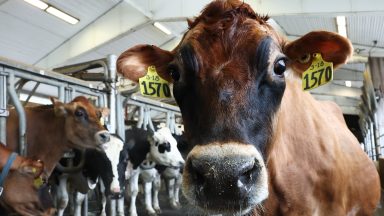
California Governor Gavin Newsom declared a state of emergency in response to a recent bird flu outbreak among dairy cows.
Since August, officials have identified the virus in 645 dairy herds across California—more than in any other state.
Find out more below.
Updates on Bird Flu Cases in the U.S.
Since bird flu was first detected in dairy farms in the United States in 2022, it has spread to hundreds of cattle herds across 16 states and caused mild infections in some dairy farm workers.
 ITHACA, NEW YORK – DECEMBER 11: A sample of milk is taken from a cow from a non-suspect herd to be tested at the Cornell Teaching Dairy Barn at Cornell University on December 11, 2024 in Ithaca, New York. (Photo by Michael M. Santiago/Getty Images)
ITHACA, NEW YORK – DECEMBER 11: A sample of milk is taken from a cow from a non-suspect herd to be tested at the Cornell Teaching Dairy Barn at Cornell University on December 11, 2024 in Ithaca, New York. (Photo by Michael M. Santiago/Getty Images)The H5N1 strain of the virus was first identified in the U.S. in March of this year. Since then, 61 people across seven states have been reported to have contracted the virus. The country’s first severe case of H5N1 was confirmed in Louisiana. The CDC reported, on X, formerly known as Twitter, “CDC confirms first severe case of H5N1 bird flu in the U.S. While an investigation into the source of the infection is ongoing, it has been determined that the patient had exposure to sick and dead birds in backyard flocks.”
The Louisiana resident, who was over the age of 65 and contracted the virus, has died, according to several reports, including CNN.
H5N1 is considered the most pathogenic of bird flu strains, meaning it is particularly deadly, with a fatality rate of approximately 60% in humans.
 ITHACA, NEW YORK – DECEMBER 10: Milk samples are seen as a lab manager in the molecular diagnostic lab prepares them for testing at the Animal Health Diagnostic Center at Cornell University on December 10, 2024 in Ithaca, New York. (Photo by Michael M. Santiago/Getty Images)
ITHACA, NEW YORK – DECEMBER 10: Milk samples are seen as a lab manager in the molecular diagnostic lab prepares them for testing at the Animal Health Diagnostic Center at Cornell University on December 10, 2024 in Ithaca, New York. (Photo by Michael M. Santiago/Getty Images)Why Did Newsom Declare a State of Emergency?
Of the 61 reported cases of bird flu in the U.S. this year, 34 have been in California.
In response to the outbreak, Governor Newsom issued a statement regarding the state of emergency: “This proclamation is a targeted action to ensure government agencies have the resources and flexibility they need to respond quickly to this outbreak. Building on California’s testing and monitoring system — the largest in the nation — we are committed to further protecting public health, supporting our agriculture industry, and ensuring that Californians have access to accurate, up-to-date information. While the risk to the public remains low, we will continue to take all necessary steps to prevent the spread of this virus.”
What Is a State of Emergency?
A state of emergency is a formal declaration by a governor or government that temporarily expands its authority to address a crisis or emergency situation. It is invoked when local resources are insufficient to manage the scope of the crisis, and state intervention is needed to prevent or mitigate damage, loss, or suffering.
This declaration allows the governor to expedite assistance from state agencies to affected communities, providing immediate access to essential resources such as rescue operations, evacuations, shelters, and supplies (e.g., heating fuel, food, etc.). It also enables the state to take action to control disturbances and maintain order in impacted areas.
Additionally, a state of emergency can help position the state to request federal aid if the magnitude of the situation exceeds the capacity of state resources.
What Is Bird Flu?
Bird flu, also known as avian influenza, is a viral infection primarily affecting birds but can also spread to humans and other animals in certain circumstances. The virus is typically spread through direct contact with infected birds, their droppings, or contaminated surfaces.
According to the CDC, people should avoid touching surfaces that are contaminated with infected materials from birds or other animals that are suspected to have avian influenza.
What Are the Symptoms of Bird Flu?
In humans, bird flu symptoms can range from mild to severe and may include:
- Fever
- Cough
- Sore throat
- Runny or stuffy nose
- Muscle aches
- Fatigue
- Diarrhea
- Vomiting
- Difficulty breathing (in severe cases)
In some cases, the virus can lead to serious respiratory illness or even death, particularly in individuals with weakened immune systems or underlying health conditions.

 By Hollywood Life | Created at 2025-01-08 20:10:16 | Updated at 2025-01-09 10:30:20
14 hours ago
By Hollywood Life | Created at 2025-01-08 20:10:16 | Updated at 2025-01-09 10:30:20
14 hours ago








